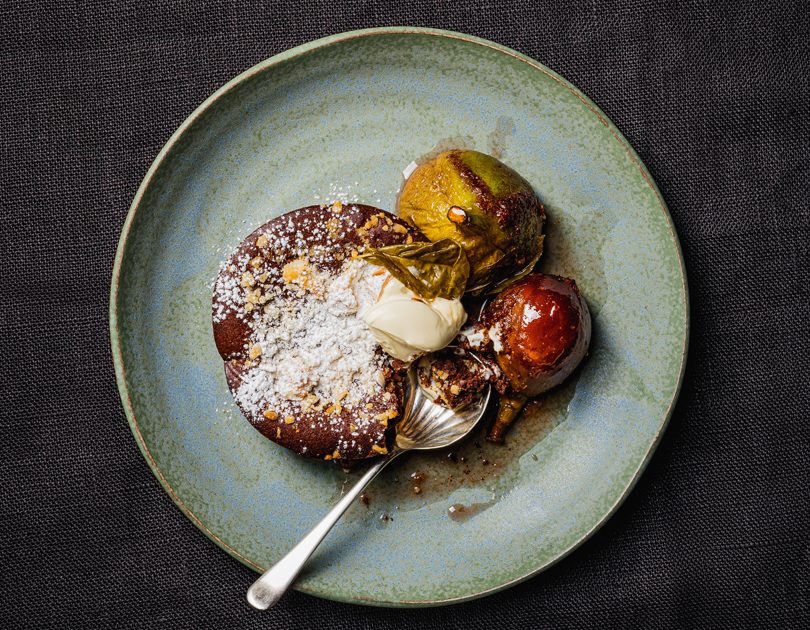Martin Bosley agrees that it is indeed a Bay of Plenty.
Bay of Plenty
The joy of regional dining is that it celebrates the land in a way that is respectful, fun and delicious. There are few better examples of this than in the Bay of Plenty. The story goes that when Captain James Cook arrived in 1769, he anchored off a great bay ‘full of plantations and villages’ that was, he noted ‘a bay of plenty’. Today, the Bay of Plenty and Te Moananui ā Toi (the coastal Bay of Plenty) is home to spectacular beaches and hectares of kiwifruit, citrus and avocados.
Mauao/Mount Maunganui is the region’s most iconic landmark, overlooking Tauranga and the Kaimai Ranges. Pāpāmoa Beach is renowned for its prime surfing conditions, fishing and white sands. To the south lie the untouched beaches of Maketū and ‘New Zealand’s Most-Loved Beach’, Ōhope. The Tauranga Market, held every Saturday morning at the primary school, is the ideal place to start exploring the best produce of the region from a growing group of boutique producers. Think Mount Eliza cheese, Kaimai Range honey, Jersey Girl Organics milk, Flavour Queen Mushrooms, sausages and charcuterie, macadamia nuts, chocolate and figs. It is as abundant as it is indulgent.
The macadamia could well be the king of nuts, or at least the most decadent, with its unique crumbly yet creamy texture and sweet, rich, buttery flavour. I add them to my hummus or make a soft vegan-friendly nut cheese to serve with raw vegetables, and I mix them into breadcrumbs if making chicken schnitzel or through a crumbly crust over a fish pie. Because of their high oil content, I keep them in the refrigerator in an airtight container.
Wyn and Chris Daniell of Harbourside Macadamias, harvest four varieties of macadamia nuts from more than 940 trees on the ede of Tauranga Harbour, near Katikati. They only harvest when the nuts are mature enough to drop to the ground. Roasted, salted and raw nuts are available, along with nuts decadently coated in dark and milk chocolate. The macadamia liqueur can be drunk on its own, mixed into cocktails or poured over ice cream. harboursidemacadamias.com
It’s no secret that I have a fondness and a weakness for chocolate; I’m more accurate at sniffing it out than a border patrol dog. I have one chocolate cake recipe that is my go-to (see recipe). A cake heart-stoppingly dark as night, its interior is tender, its texture sensuously moist. It has butter, eggs, sugar and the best dark chocolate I can find, one with cocoa solids around 70%. Success depends on the baking; it requires two stages of cooking, the second with a lid over it when the cake will drop and steam under its cover.
Glenn Yeatman selects cacao beans from the Solomon Islands and roasts them in Tauranga to create a distinctive Pacific chocolate, using only organic cacao and organic coconut sugar. Producing chocolate with a conscience, this is a social enterprise that aims to assist Solomon Island landowners to improve their standard of living and improve their communities. The 70% Chocolate Pieces are dairy-, nut- and gluten-free, ideal for baking. solomonsgold.co.nz
A mouthful of honey spread on toast is usually all I need to start the day. Beyond that, honey is endlessly useful in my kitchen. As well as mixing it with cinnamon, cloves and nutmeg for some honey-scented pastries, the nectar has a near-mystical alliance with poached fruits; a sweetener for peaches poached with lemon verbena or in a red wine syrup with basil leaves for ripe figs. Jody and Ralph Mitchell from Kaimai Range Honey produce velvety-smooth raw speciality honeys, creamed at low temperatures to preserve the flavour and nutritional qualities. Search Facebook for Kaimai Range Honey
Besides berry fruits, persimmons, passionfruit and tamarillos, the Katikati-based team from Elanza Fresh grow Cadenza and Eleganza figs using sustainable farming methods including minimal water usage. Translating to ‘fall’ in Italian, large Cadenza figs are harvested only when the fruit falls from the stem. The smaller Eleganzas are the perfect mouthful, alone and unembellished, needing nothing to improve the flavour or texture.
There is something about the fig that is profoundly beautiful and they are immensely satisfying to eat. The season is so short that it seems a shame to waste them and figs deserve the grandest of treatments. They can be eaten skin, seeds and all with a soft, ripe goat’s cheese; roasted with bacon and tossed with walnuts for a salad; served simply with prosciutto ham; or baked into a tart with an almond frangipane mixture. elanzafresh.co.nz












